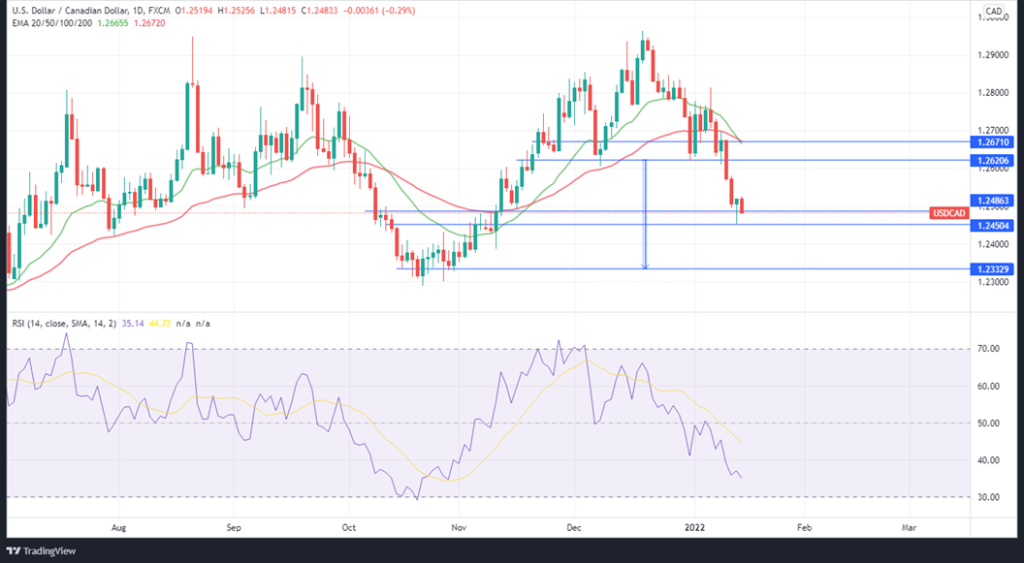- High unemployment and inflation are driving bearish sentiment against the USD.
- Rising crude oil prices prop up CAD.
- Surging Covid-19 cases a cause for concern.
The US dollar fell further on Friday, as high inflation US figures permeated the market, prolonging the bearish sentiment around the dollar. At the time of writing, the USDCAD pair was trading at 1.2483, having shed 0.29% in 24 hours.
High inflation and rising unemployment send the dollar tumbling
The market is primarily reacting to rising inflation and disappointing unemployment figures from the US. On Thursday, the Labor Department reported a rise in unemployment filings to 230,000 for the week ending January 8th. That was significantly above the consensus estimate of 200,000. The figure was also above the previous week’s numbers by 23,000.
Meanwhile, the Labor Department also reported that the Producer Price Index (PPI) was 0.2%. That was below the expected 0.4%. However, 2021 registered a record-setting 9.7%, exacerbating inflation fears.
In addition to inflation, a rise in the US unemployment claims strengthened the bearish view of the dollar. The US dollar’s troubles began earlier in the week as the market interpreted Fed Chair Jerome Powell’s statement as “less hawkish”. In the immediate aftermath of Powell’s remarks, the dollar tumbled by about 0.4%.
Rising oil prices prop up the loonie
As the USD struggled to find footing, the Canadian dollar inched higher, as global crude prices went above the $82 mark.
Oil prices inched up on Friday, and the Fed’s decision to delay raising interest rates is likely to sustain oil demand in the immediate future. Senators on Tuesday heard testimony from Federal Reserve Chairman Jerome Powell who said the central bank plans to return to a more normal monetary policy in 2022.
As a barometer for inflation, the loonie tends to fare well in the commodity market. The National Bank of Canada announced early Tuesday that Canada’s economy will be in surplus in the first quarter of 2022.
Rising commodity prices, a current account surplus, and a solid labor market form a strong foundation to keep the CAD strong for the foreseeable future. Supply constraints have helped keep high the price of oil, Canada’s most important export.
Covid-19 poses a new challenge
In the meantime, the oil market remains cautiously optimistic, as Covid-19 cases continue to pile up. In particular, China is instituting measures that could substantially reduce the demand for oil. China has placed millions of people under lockdown, triggering renewed concerns over the economic consequences.
In addition, Hong Kong has banned transit passengers from 150 places. China is struggling to control infections surge in line with its “zero Covid” policy a few weeks to the start of the Winter Olympics.
Beyond China, Europe also stares at the prospect of having 50% of its residents infected, according to the World Health Organization. The global health body has stated that this could happen within the next two months. If such a situation leads to widespread lockdowns, it could weaken the commodity-dependent CAD.
Reduced demand for oil could spell trouble for the Canadian dollar in the near term. Nonetheless, some analysts are of the opinion that the market seems to be handling Omicron with greater confidence. This may be true, but the complexities of the Covid-19 mutation mean that the future is uncertain.
The current market confidence is driven by high vaccination rates. However, a statement released by WHO paints a gloomy picture of the effectiveness of vaccination in the coming days. The global health body warned on Tuesday that booster doses of the original Covid-19 vaccine may not be a good strategy against new variants.
Technical analysis
The USDCAD formed a head and shoulders pattern and has broken below the neckline at 1.2620. The RSI is currently at 38 and below the 14-SMA, signaling weak momentum. Therefore any upward action is likely to find a barrier at 1.2671. The first support is likely to be just below the crossover of the 20-EMA above the 50-EMA at 1.2486.
Currently, the 20-EMA (green line) is slightly above the 50-EMA (red line), and based on current momentum, a downward crossover looks imminent. If that happens, the price could trigger the second support at 1.2450. Beyond that point, it could validate the measured target of 1.2332.





